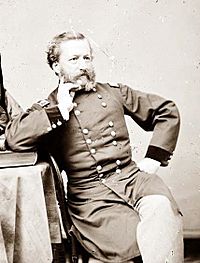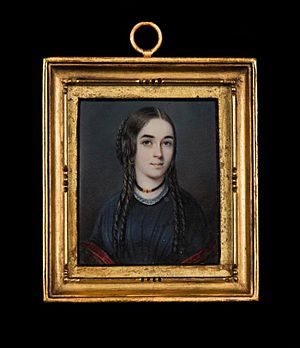Joseph Barnes (American physician) facts for kids
Quick facts for kids
Joseph Barnes
|
|
|---|---|

Maj. Gen. Joseph K. Barnes
|
|
| Birth name | Joseph K. Barnes |
| Born | July 21, 1817 Philadelphia, Pennsylvania |
| Died | April 5, 1883 (aged 65) Washington, D. C. |
| Place of burial |
Oak Hill Cemetery, Georgetown, Washington, D.C.
|
| Allegiance | United States of America Union |
| Service/ |
United States Army Union Army |
| Years of service | 1840–1882 |
| Rank | |
| Commands held | Surgeon General of the U.S. Army |
| Battles/wars | Second Seminole War Mexican–American War American Civil War |
Joseph K. Barnes was an important American doctor who became the top doctor for the U.S. Army. He was the 12th Surgeon General of the United States Army from 1864 to 1882. He was born on July 21, 1817, and passed away on April 5, 1883.
Joseph K. Barnes: A Military Doctor's Life
Early Life and Medical Training
Joseph K. Barnes was born in Philadelphia, Pennsylvania. His father was a successful judge. Joseph started studying medicine at Harvard University. He later got his medical degree from the University of Pennsylvania in 1838.
After finishing his studies, he worked as a resident doctor at Blockley Hospital. He also served as a visiting doctor in Philadelphia for a year.
Joining the Army and Serving in Florida
In 1840, Barnes joined the U.S. Army as an assistant surgeon. His first assignment was at the United States Military Academy at West Point.
Soon after, he was sent to Florida. At that time, there was fighting against the Seminole Native Americans. For two years, he worked at many different army posts in Florida. He often had to cover several posts because there weren't enough doctors. He even went on an expedition through the Everglades during the Second Seminole War.
Serving in the Mexican-American War
In 1846, the Mexican–American War began. Barnes joined the army heading to Mexico. He served with General Zachary Taylor's army as they moved towards Monterey.
Later, he joined General Winfield Scott's forces. He helped during the capture of Veracruz. He was the chief surgeon for the cavalry during the advance on Mexico City. He was present at several important battles, including Cerro Gordo and Chapultepec.
After the war, Barnes served at many different army posts across the country for 13 years. These included posts in Texas, Kansas, and on the Pacific coast. He was promoted to major and surgeon in 1856. He married Mary Thurston Fauntleroy at Fort Leavenworth, Kansas.
The Civil War and Becoming Surgeon General
When the American Civil War started in 1861, Barnes was stationed at Vancouver Barracks in Washington Territory. He was soon ordered to the east.
He became a medical director for different army departments. In 1862, he was assigned as the attending surgeon for Washington, D.C. Here, he met Secretary of War Edwin M. Stanton, who was very impressed with him.
In 1863, Barnes was promoted to medical inspector with the rank of lieutenant colonel. Later that year, he became medical inspector general with the rank of colonel. Because of some issues with the current Surgeon General, William Alexander Hammond, Barnes was asked to take charge of the Medical Department.
On August 22, 1864, Joseph K. Barnes officially became the Surgeon General of the United States Army. He was given the rank of brigadier general. In 1865, he was given the honorary rank of major general for his excellent service during the war.
Attending President Lincoln
On April 14, 1865, President Abraham Lincoln was shot. Surgeon General Barnes was one of the doctors who attended to President Lincoln on his deathbed. He also helped Secretary of State William H. Seward, who was also attacked that night, recover from his injuries.
The day after Lincoln's death, Barnes oversaw the autopsy of President Lincoln's body. This was done by other army doctors.
Medical Museum and Hospitals
During his time as Surgeon General, Barnes worked hard to collect materials for the Army Medical Museum. He also pushed for the creation of the Medical and Surgical History of the War of the Rebellion. This was a huge project to document the medical experiences of the Civil War.
He also helped make sure that medical officers had the right to command in army hospitals. This was important for doctors to do their jobs well. He also made sure the medical department had full control over hospital transports and boats.
After the War and Retirement
Under General Barnes's leadership, four of the six large volumes of the Medical and Surgical History of the War of the Rebellion were completed. The other two were almost finished when he retired.
He also greatly helped the Army Medical Library grow. Under his supervision, the library became one of the best medical libraries in the country. In 1871, he helped start the Philosophical Society of Washington, a group for scientists.
President Garfield's Illness
In 1881, President James A. Garfield was shot. Barnes was one of the surgeons who cared for the dying president for many weeks. The stress of caring for the president took a heavy toll on Barnes's own health.
In 1882, a new law made it mandatory for army officers to retire at a certain age. Barnes was past that age, so he retired on June 30, 1882.
Death
Joseph K. Barnes passed away at his home in Washington, D.C., on April 5, 1883. He had been suffering from a long-term kidney illness.
Images for kids




